
Honda Civic review

Introduction
The Honda Civic is one of those motors that, despite retaining the same name for many years, looks nothing like its predecessors.
Indeed, this one is the tenth generation of the Civic since it first became a thing back in 1972 – and very soon, it'll be replaced by generation eleven.
Apart from the exciting Type R version, it wasn’t until the UFO-shaped eighth generation came along in 2005 that the Civic did anything memorable. Until then, it looked like another bland, family hatchback driven by people who weren’t bothered about cars.
Since then, though, it’s spent 15 years as a desirable car, with sharp edges on a rounded body.
Review Sections
Select's rating score* - 4.2 / 5
At A Glance
The current version is more jagged and dynamic, especially at the rear. It looks chiselled, with fake rear air intakes, a wide hexagonal number plate housing, and so many angles that your eyes don't know which bit to look at.
The taillights, for example, stick out at their extremities, creating a rear spoiler, while a modest roof spoiler bridges over the top of the rear window.
Down the side, it’s a more modest affair, but there’s still room for a substantial, tapering indentation at the bottom of the doors, rising towards the rear wheels.
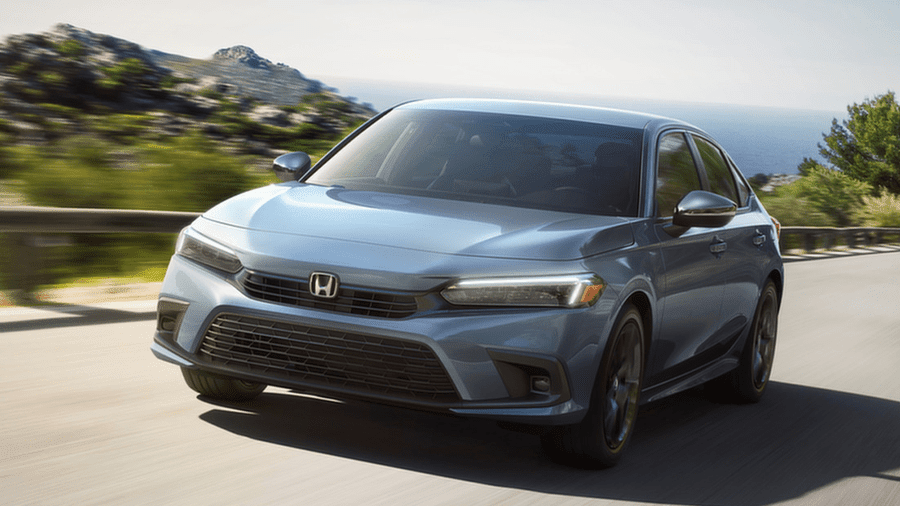
The front is angular, too, with a mean frown. Meanwhile, the air intakes are built into the front bumpers, which causes them to stick out like cheekbones. This design makes the lower half seem further forward than the rest of the front end.
Some may think the design is far too busy and, indeed, it's a car aiming at a more youthful audience than historic Civics have. But the looks are controversial. At least it's not dull, though.
If you want to like it but aren't sure, a quick internet search of 'Honda Civic 1983' will leave you drooling at what it looks like today.
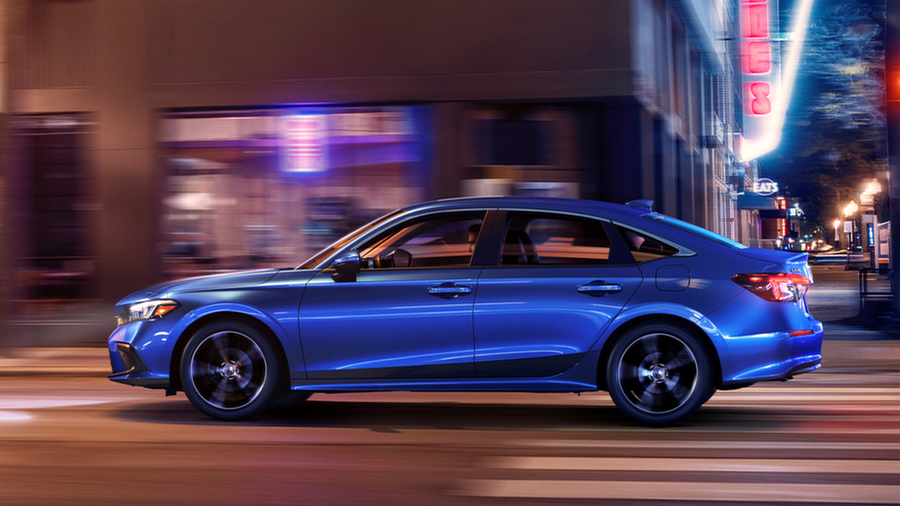
Key Features
Four trims are available on the Honda Civic nowadays. There used to be more, but the entry-level S was so basic that it's been discontinued (unbelievably, for a brief period, it didn’t even include a radio).
Thankfully, that means we start with the SE, which gets 16-inch alloy wheels, and a five-inch monitor to control the DAB radio. You also get Bluetooth telephone connectivity, front and rear parking sensors, climate control and electric windows.
Next is the SR trim, which gets bigger 17-inch alloy rims, and a seven-inch Honda CONNECT touchscreen infotainment system with Apple CarPlay, Android Auto and a Garmin SatNav. You also get dual-zone climate control, halogen fog lights, privacy glass, a leather steering wheel, a rear parking camera, alloy pedals, rain-sensing wipers, driver's lumbar adjustment, ambient lighting, and power-folding door mirrors.
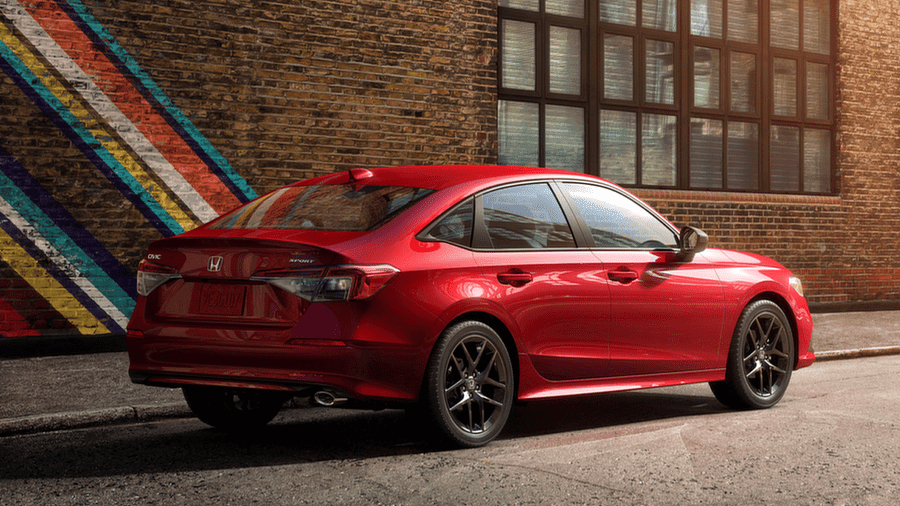
The EX grade boasts leather heated front and rear seats, blindspot monitoring, adaptive dampers, keyless entry/exit, cross traffic monitor and eleven speakers (instead of eight on lower trims). You also get a passenger seat lumbar adjustment, wireless phone charger, plus LED fog lights and headlights with washers.
The top-of-the-range EX Sport Line trim features black 17-inch wheels, a new seat pattern, a body kit, a higher quality interior panel design and a rear deck spoiler.

Performance & Drive
All trims must make do with a 1.0-litre VTEC turbo petrol engine, which doesn’t sound especially impressive.
On the other hand, despite the Civic’s look being influenced by the hot-hatch Type R version, the standard car isn’t a hot hatch. Therefore, the small powerplant shouldn’t come as a surprise, especially in this day and age and, at 129PS, it’s not bad.
It gets to 62mph in 10.5-seconds, and, although that's not outstandingly fast, it's still more than adequate and a match for its closest challengers.
You can have a six-speed manual, but our test car comes with the CVT automatic gearbox. If you're not familiar with CVTs, it means 'continuously variable transmission', so there's only one gear that makes the necessary adjustments to help you on your way.

In all honesty, the gearbox isn’t all it’s cracked up to be because there isn’t much power. So if you want to get where you're going quickly, you have to thrash it a bit, and the CVT generates high revs, which makes things noisy. Moreover, the road noise through the tyres doesn't help, either.
Unless you hate changing gear, we'd advise sticking with the smooth manual, which feels more refined. However, you still need to work the engine hard if you're in a hurry.
The Civic’s pretty good but not class-leading in terms of ride comfort. The suspension is helped by the active dampers that can be made softer or firmer at the touch of a switch, depending on your preferences. However, lower trims without the feature are perfectly okay, and there's little justification for having a higher grade just for the upgraded suspension system.
When the car’s in softer mode, it's absorbing and comforting, effortlessly smoothing out imperfections in the road. In comparison, the firmer setting sharpens things up for those who prefer keener handling and want to chuck it about into corners. There is a decent level of grip, although some competitors are more fun to drive.
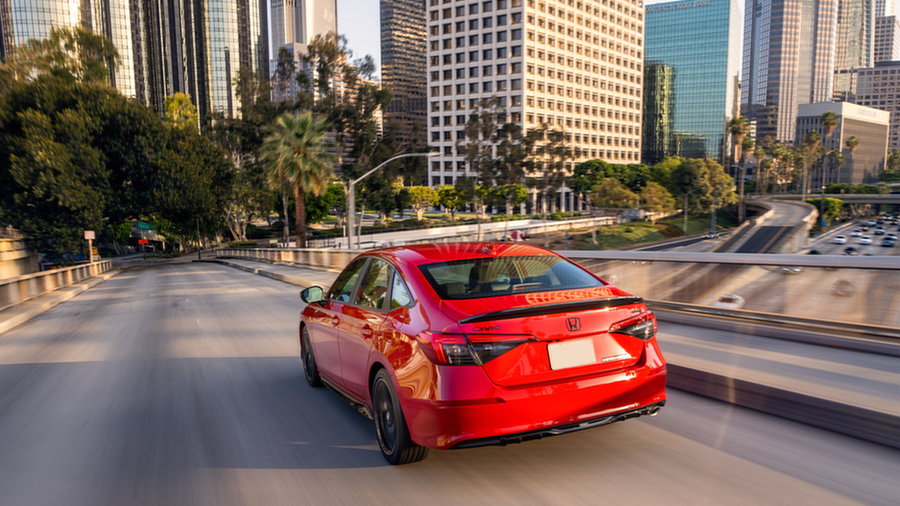
Speaking of fun, the Honda does handle reasonably well, but the steering doesn't weight up as much as we'd like. Consequently, it restricted our confidence in throwing the Civic into a bend. On the other hand, the steering is light and accurate at lower speeds, so driving doesn't get tiring if you're constantly changing direction around the meandering turns of a town centre.
All in all, it's a decent vehicle to drive in most situations. And, although the Civic’s hardly a slouch, those who want sharp driving dynamics will probably opt for a competitor or resign themselves to forking out the extra for the hot-hatch Type R version.
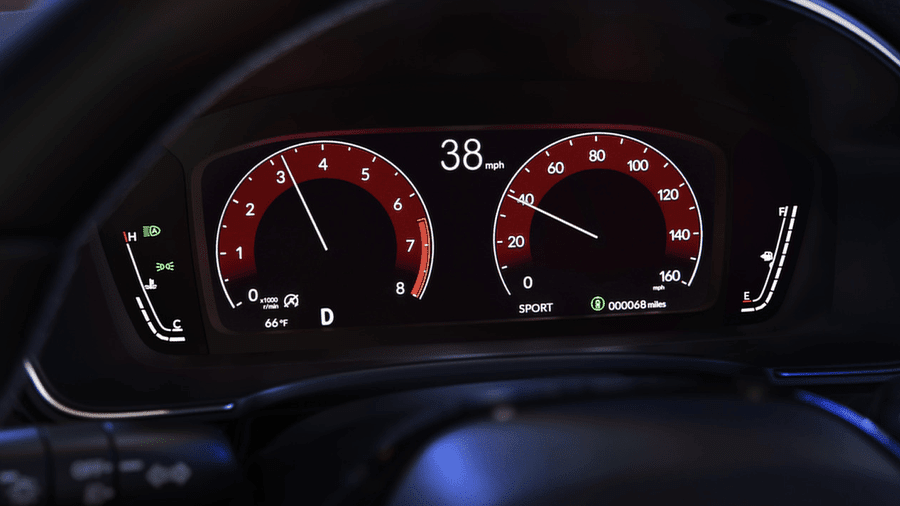
Running Costs & Emissions
The Civic’s 1.0-litre turbocharged VTEC engine produces 114g/km CO2 in our test car. But it’s reduced to 110g/km if you opt for the manual gearbox, which is enough to save you on road tax, as it’s in the next band down.
Fuel consumption is 42.8 to 46.3mpg with the CVT transmission and 49.5mpg in the manual gearbox.
These figures are in the same ballpark as the Civic’s rivals unless you opt for hybrid variants.
Speaking of hybrids, while 110g/km is pretty good, company car users will be looking towards plug-ins and all-electric cars to save money these days.

Servicing costs tend to be on the high side compared with rivals, but you should be able to get a complete service for less than £200.
Despite Japanese manufacturers' excellent reputation nowadays, Honda tends only to have average reliability. However, other Far Eastern marques such as Kia and Hyundai have fared better recently and offer seven and five-year warranties, respectively.
With Honda, you only get a three-year warranty, limited to 90,000 miles, although that’s still better than many manufacturers who limit it to 60,000 miles. So, even though you're leasing, this information might help you pull the trigger on which car you lease.

Interior & Technology
The inside of the Civic looks nice without the premium trimmings you get on something like a BMW 1 Series.
Plenty of plush soft-to-the-touch surfaces are included, but more rigid scratchy plastics are lower down. Nevertheless, it feels solid, well built and made of mostly quality materials.
Nothing stands out in terms of looks, and the cabin doesn’t ooze classiness. But it still looks nicely designed, with plenty of silver to add a bit of uplift to the darkness of the upholstery. The infotainment touchscreen sits to the left of the steering wheel without protruding over the top of the dashboard.
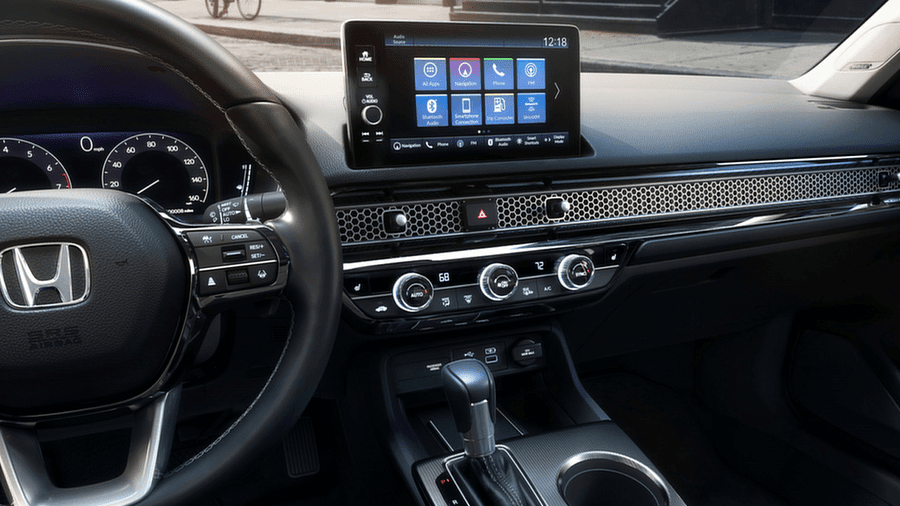
The infotainment system itself is a disappointment, though. It is slow to respond and generally behaves like an old smartphone. It isn't helped by the menus, which aren't laid out in a particularly intuitive way, and, consequently, it's convoluted and inferior to nearly all its main rivals.
Thankfully, the inclusion of Apple CarPlay and Android Auto means you can use that instead, but the system needs a significant overhaul. It is still better than nothing, so the entry-level SE trim is best avoided because you don’t get the system at all. But the seven-inch screen in the rest of the range isn’t much to write home about.
There is some good news: Honda has left the physical dials to adjust the climate control system, unlike some rivals who have replaced them with touch-sensitive haptic buttons. Or, even worse, they’ve buried them within the infotainment touchscreen completely, which likely would have made it a nightmare to change the temperature.

There is plenty of visibility out of the front, as the pillars aren't incredibly thick, but thanks to the shape of the roofline, they are meatier at the back, restricting your view.
Regarding the driving position, there’s a sense of hunkering down in the Civic. It is not low to the ground like a sports car, but you feel you’re sitting relatively low when you climb into the driver’s seat. If you prefer, it can be raised.
Thanks to the steering wheel and seat adjustment, getting comfortable is easy enough, although the lumbar support could be less fiddly to alter when using the provided lever.

Practicality & Boot Space
The front has ample head and legroom, so you can sprawl out and relax while driving.
In the rear, even taller passengers won't complain about the legroom, which is generous. Still, the reasonably aggressive slope of the roofline somewhat limits headroom, so the tallest of adults in the back might be less comfortable on longer journeys.
It is not bad, but challengers like the Ford Focus are still better.
You can fit a trio of adults in the back but, again, for longer journeys, it's not suitable. If you have three kids, though, they won’t be complaining.

Several storage areas are offered inside, with good-sized door bins, a reasonably sized glove compartment and a cubby beneath the central armrest, which features a sliding opening.
Boot space measures a generous 478 litres, expanding to 1,580 litres with the rear seats down, which fold away in a 60/40 split. What’s more, the boot opening is invitingly wide.
There is also some storage underneath the cargo floor, which is included in the boot capacity figure. But there's a sizeable boot lip, which makes lifting heavier or bulkier items in and out a faff.

Safety
One area in which Honda generally excels is safety – and the current Civic is no exception.
It earned a five-star rating when crash-tested by Euro NCAP back in 2017, which was a re-assessment after Honda modified some features, unhappy with the four-star score it was initially awarded.
The Civic scored 92 per cent for adult occupants, 75 per cent for children and 88 per cent for safety assists.
The latter scored well thanks to the inclusion of many safety features as standard, some of which are part of Honda’s SENSING technology.
Hill start assist, City Brake active system, automatic emergency braking, vehicle stability assist, lane keep assist, lane departure alert, traffic sign recognition, and intelligent speed assist are standard. You also get forward collision warning and intelligent adaptive cruise control.
That is all in addition to the safety features we tend to take for granted on cars nowadays, such as airbags and anti-lock brakes.
In our EX-trimmed test car, we also get blind spot monitoring and a cross-traffic monitor.

Options
There are numerous options for upgrading and personalising your Honda Civic.
The Bronze Line and Red Line packs add body kits which, unsurprisingly, feature bronze or red colouring to make the car look sportier, along with coloured mirror caps and a rear diffuser. At the same time, each item is available individually.
You can also add 18-inch alloys with the packs, with a choice of bronze and silver, or red, silver and black, while the windows can be de-chromed if you prefer an all-black colour.

There is also a Premium Pack which helps to protect various parts of the Civic from scuffs and scratches. These include doorstep and boot step protectors, mud guards and floor carpets. Again, each item in the pack can be ordered individually if you don’t want all of them.
If you want to protect the boot, there's a waterproof, anti-slip, washable cargo protector. This can be taken out and cleaned, so if you're regularly using your Civic to head off hiking or doing muddy activities, this might be an option worth considering.
A wireless phone charger can be added in models where it’s not included as standard, while tablet holders are available, which attach to the back of the front seats.
Other accessories available include a roof box, bicycle carrier, detachable tow bar and an Illumination Pack, which adds some nice ambient lighting.

Rival Cars
Most of the current Civic's core competitors can't beat it in terms of personality, but all have better infotainment systems.
The SEAT Leon is more fun to drive, while the Skoda Octavia is roomier in the back than the Civic.
Ford’s Focus is an obvious alternative, too, with better all-around drivability and roomier rear seats.
The Volkswagen Golf is also a popular rival, providing more comfort, but it has a smaller boot.
Furthermore, Mazda is an underrated brand nowadays and the ‘3’ is worth looking at.
Finally, the full hybrid Toyota Corolla deserves your consideration if you want fuel economy.

Verdict & Next Steps
Overall, the Honda Civic is a respectable contender.
Its personality packs a punch, although the chiselled-out Type R-inspired design may not be to everyone's tastes. But nobody can accuse it of being bland.
The Civic is good to drive, practical and quite roomy unless you’re incredibly tall and sat in the back, while the handling is decent but not exceptional.
Manual gearboxes are more refined and preferred in the Civic as, although the 1.0-litre turbo VTEC engine isn’t bad, it sounds like it’s being thrashed if you opt for the CVT that we tested.
Thrill-seekers will need to look at challengers such as the Seat Leon. On the other hand, if your heart is set on the Civic, then the Type R might suffice – but only if you have deeper pockets.
Those who love to fiddle about with infotainment systems are best off putting a line through the Civic altogether, however. Likewise, the Civic is not a class leader if you want a quiet ride.
In terms of our EX trim, it's good, but the price difference in terms of the SR (the next trim down) means it's not worth it. We would undoubtedly avoid the entry-level SE model, but anything above the SR dramatically diminishes the value for money.
The Civic is quite a frustrating car. It had so much going for it – and it’s certainly not bad by any stretch of the imagination.
There is a niggling feeling at the back of our minds that it could have been so much better with a bit more attention to detail. Maybe the next Civic will address the issues we've found with this current model.
Where to next?
View our latest Honda Civic Leasing Deals - from just £372.16 per month inc VAT**
Looking for a great leasing deal? Check out our incredible range of Special Offers
New Estate? Read our latest Car Reviews and find the right model for you
Want to know more about leasing? Take a look at our comprehensive Leasing Guides
Interested in everything motoring? Why not catch up on all the latest Car Leasing News.
*Score based on Select’s unique meta score analysis, taking into account the UK’s top five leading independent car website reviews of the Honda Civic
**Correct as of 20/09/2022. Based on 9 months initial payment, 5,000 miles over a 48 month lease. Initial payment equivalent to 9 monthly payments or £3,349.44 Ts and Cs apply. Credit is subject to status.






















